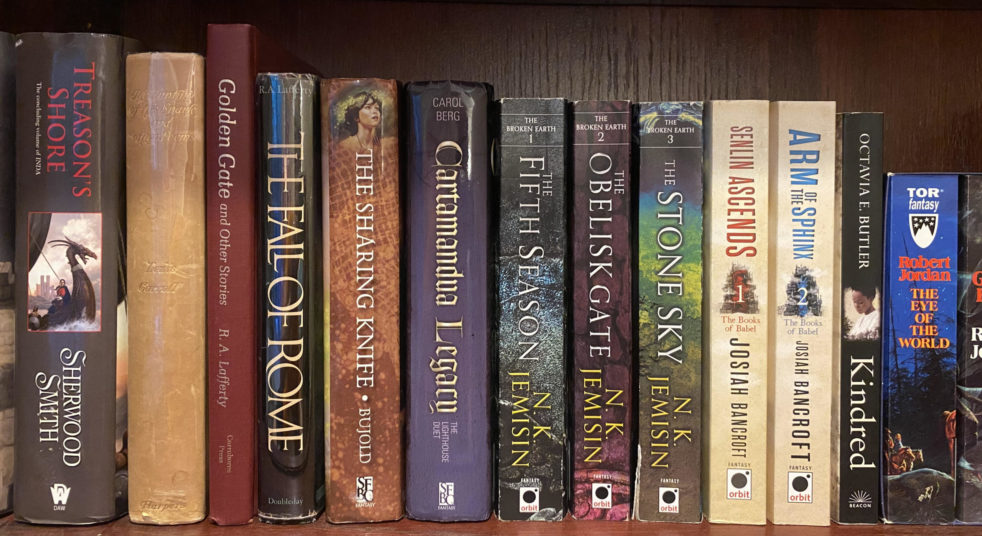I am running out of ways to say that I read Clarkesworld and GigaNotoSaurus every month. There’s always some good stuff to recommend, so let’s take a look.
Clarkesworld
The May 2025 issue of Clarkesworld has a little bit different story mix than usual, with one full novella as a centerpiece, balanced by a pair of unusually short stories serving to open and close the fiction section.
The first of the shorter pieces is Brainstem Disco, 2191, and while I tend not to enjoy stories that creep down near the flash boundary, I’d had enough good experiences with author Angela Liu that I was nevertheless excited to give this one a try. But while it’s an engaging piece that hits some of the themes Liu writes so well—particularly grief and memory—it’s also a very short one that didn’t build enough emotional connection to truly hit the way some of her others have.
It’s followed by The Library of the Apocalypse by Rati Mehrotra, a post-apocalyptic (or perhaps just apocalyptic) science fantasy in which a misfit band struggles to survive a harsh urban landscape with little food and plenty of dangers, all while seeking the mysterious library that periodically appears and sends each on sometimes-temporary adventures to other places, times, or worlds. This one is gripping in its storytelling, quickly establishing the heartwrenching reality that some never return from the library, and yet are unwilling to resign themselves to a life without it. And while the vibes are compelling, the development of the main character over the course of the tale gives the story some depth beyond just those compelling vibes.
We, the Fleet by Alex T. Singer is a first contact story told from the perspective of machine intelligences who hadn’t met a human before. It’s exactly the sort of story that I so often enjoy, and the execution was excellent, fully establishing the alienness of the leads and slowly opening their eyes to another way of living.
The issue’s extended centerpiece is the novella Descent by Wole Talabi. I’ve enjoyed a lot of Talabi’s short fiction, including a very nice novella from last year that used a post-apocalyptic setting for a mythic retelling, but while this one shows flashes of his talent, it isn’t balanced to really strike at my heart. A lot of readers really love digging into the details of the worldbuilding and the science, but as someone who prefers my worldbuilding a touch understated, these elements struck me as a bit too prominent here. But there’s also plenty of interpersonal drama, particularly between the lead and a mother figure—a theme Talabi used wonderfully in one of my favorites of his, “A Dream of Electric Mothers”—that kept me engaged, and the character work left me with an overall positive impression here.
The second half of the issue kicks off with a pair of stories featuring truly massive scale, starting with Oh Time Thy Pyramids by Ann LeBlanc. It’s an engaging and ambitious tale of a sentient, immortal funereal statue walking away from endless worshipping to explore the world and more of her Queen’s conquests. There were times here where I found the scale so staggering that it was hard to get a grasp on the story, but there are still personal stakes here, and there’s enough storytelling skill that I have no doubt this one will find its fans.
Proxima One by Caryanna Reuven, translated by Sue Burke, provides another story from a long-lived, non-human perspective, as a probe designed to search the cosmos for intelligent life sets off on a multi-faceted journey of exploration. This one does some clever things with time and perspective and stays engaging throughout, but while it does come together into something of a narrative, it feels mostly like a high-concept series of vignettes.
The issue closes with Yarn Theory by Marie Vibbert, a tale that barely eclipses the industry-standard definition of flash fiction but feels a lot like flash to me. It’s a well-written piece about a mathematician using knitting to think through a difficult problem of extraterrestrial communication, but as I so often find with flash fiction, it’s not a story I’d still think about a day later.
The nonfiction section includes an editorial in which Clarke draws a comparison between short fiction publishing and an annual medieval festival at his college. The big idea is that sometimes one must think outside the box to build something that will last through the inevitable shockwaves. What that thinking may be in the case of Clarkesworld is unclear, but it’s always nice to see the ways in which he’s thinking through sustainability in an industry with such high turnover.
The science article covers symbiosis in science and fiction, and the two interviews continue the recent trend of highlighting figures who are not primarily known as print fiction writers—in this case TV writer Jane Espenson and podcaster David Barr Kirtley. I’ve liked a whole lot of Espenson’s TV writing (and enjoyed some of her print fiction as well!), and while I’m not a podcast listener at all, Kirtley’s interview was intriguing enough to make me curious about his work.
GigaNotoSaurus
This month’s longish short fiction in GigaNotoSaurus is the novelette Shadow Jack by CL Hellisen, the grisly tale of a boy raised as an altar boy in a temple to ultimately serve as the sacrifice that allows one of priests to take a god into human form. I don’t have a lot to complain about with the writing style here, but sacrifices and horror stories are pretty far outside the sort of fiction that I tend to enjoy, and I ultimately wasn’t the right reader for this one.
May Favorites
- “The Library of the Apocalypse” by Rati Mehrotra (short story, Clarkesworld)
- “We, the Fleet” by Alex T. Singer (novelette, Clarkesworld)
